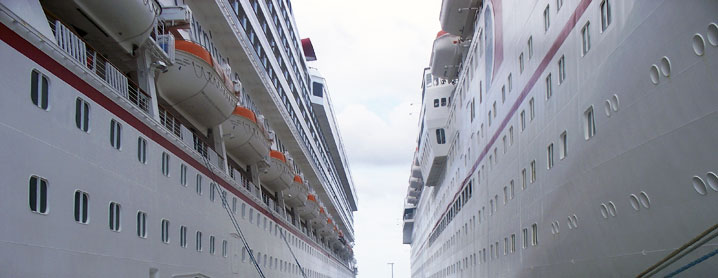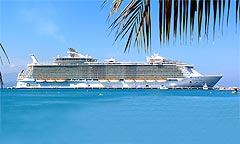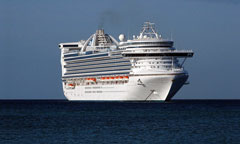The Cruise Industry
General Analysis and Overview
General analysis and overview of the modern cruise industry and its development in the last decades.

General analysis and overview of the modern cruise industry and its development in the last decades.

Over the last decades, the modern cruise industry has responded to extensive market and consumer research with the presentation of innovative naval design concepts, new ship lengths, ever more exotic destinations around the globe, and new on-board and on-shore activities and themes, developed to offer a vacation alternative that satisfies the expectatives of everyone.
The cruise industry, which modern version dates from the 1970s with the development of the North American industry, has experienced an increasing process of popularization, becoming a major part of the tourism sector, and reaching a level of enormous significance world-wide as an economic factor.
The modern cruise industry is also one of the most outstanding examples of globalization, with an increasing number of ports of call and destinations around the globe, a multinational clientele and onboard personnel from every continent, and a level of detachment from communities and nations never seen before in history, with important economic, legal, environmental and social implications.
A crisis-resistant industry with a diversified offer of airlift options and modernized port structures that have open up cruising as a vacation alternative available for an increasing, more affluent customer base, offering a exciting, eventful, relaxing and definitely enjoyable experience for millions of passengers from across the world each year.
This dynamic sector is continuously expanding its offer of products and services, and developing new markets, with an average 8.5% annual growth in the last 20 years, and nearly 90 million passengers since 1980, 60% percent of whom have been generated in the past decade, in a tendency that shows no sign of slowing, with 13 and 13.5 million passengers in 2008 and 2009, compared with the 12,6 million in 2007, and that is expected to continue through the 21st century.
In terms of capacity, the cruise industry has also experienced unprecedented development since the turn of the century. During the 1980s, around 40 new cruise ships were built and put in service, followed by other 80 vessels along the 1990s, and a 40% increase between 2000 and 2005 that will be completed by and additional 25% of new state-of-the-art units to replace ships that are expected to be withdrawn in the next years.
A multimillion investment into new, more innovative and ever-bigger vessels capable of carrying up more than 3,000 passengers, offering lower fares and shorter cruises to benefit from economy of scale and onboard activities such as multi-story shopping centers, restaurants, cafés and pubs, nightclubs, discos, casinos, art galleries and museums, theatres and cinemas, libraries, personal care areas and spas, gyms, swimming pools, tennis courts, ice skating rings, and a long etcetera of amenities to meet the changing vacation patterns of today’s market and exceed the expectations of its customers with practically a cruise option for everyone.
A fleet compossed of several hundred large cruise ships carrying millions of passengers plies routes in all geographical areas in an expanding range of more than 500 destinations worldwide, with the Caribeean cruises as the favourite ones, followed by Mediterranean cruises and European itineraries that visit diverse popular ports and cities – Barcelona, Venice, Nice, Athens and the Greek Islands, Monte Carlo, Istambul, London, Amsterdam, the Scandinavial Fjords, Helsinki, San Petersburg, etc. –, including also the opportunity to enjoy places not included in the usual offer presented by other travel and tourism service providers, such as Artic and Antarctic regions.
Indeed, the cruise industry has increased in popularity all around the world, serving an heterogeneus clientele with well-differentiated expectations and preferences in the Asian, European and North American markets.
This phenomenal growth has also created the need for more efficient managerial, organizational and planning structures to best the increasing competition and deal with the many changing factors in an also evolving market that generates over $15 billion every year – 79% of which corresponds to the North American and British markets – and hundreds of thousands of direct and indirect jobs around the world, yielding an indirect multi-billion dollar annual benefit in diverse industrial sectors in all the world (nondurable and durable goods manufacturing, professional and technical services, travel services, financial services, airline and transportation, and wholesale trade).
In the other hand, the growth of the cruise industry has been severely conditioned by diverse events, such the Achille Lauro hijack in 1985, the Iraq and Kosovo wars, and especially the aftermath of the September 11 attacks, followed by an accentuated process of restructuration and consolidation in the sector.
Renaissance Cruises was the first company to fill for bankrupcy on 25 September 2001, followed by American Classic Voyages and other four companies reflecting ten well-known brand names, ceasing operations and leaving the market wide open for the largest cruise companies – Carnival Corporation, Royal Caribbean Cruise Limited and Star Cruises – to consolidate in a process of purchasing and merging of companies giving birth to enormous corporations that control about 80% of the cruise market worldwide.
Carnival Corporation, headquartered in Miami (Florida, USA) and London (England, UK), is the undisputed leader in the sector and the most profitable leisure company in the world, with 12 cruise brands in North America, Europe and Australia that operates 89 cruise ships, around 65,000 shipboard employees and 170,000 guests at any given time.
Among the companies of more modest size in the market are Crystal (subsidiary of the Japanese NYK), Silversea and Raddisson Seaven Seas.
In the other hand, althought the corporate offices of the main cruise companies are located in the United States and Europe, and their clientele comes mostly from these same areas, these organizations, as an integrant part of the shipping industry, are incorporated and have most of their fleet registered in Panama, Liberia, Bemuda and Bahamas to obtain a series of benefits and advantages that allow a better economic balance and competitiveness derived from more favourable standards concerning taxation, labour laws and safety and environmental regulations.
The volume of the cruise ship market is relatively small, with important barriers both to entry and exit associated with the extremely high cost of purchasing or selling a single cruise ship, and the high investment needed to maintain and manage a cruise line, which has a decisive influence on diverse aspects and strategies related to organizational and management issues.
In the same way, the bargaining power and capability to take advantage of economies of scale present in the cruise industry are also affected by the size of the market in two different and contradictory ways: a) the presence of a few shipbuilders and techology developers in the industry forces the cruise companies to accept the prices and costs offered to them; b) the large number of suppliers of equipment, fuel and food products allows them to bargain for the best prices.
Such a reduced number of companies allows them to watch closely for potential commercial threats in a constant competition for a clientele influenced by general economic conditions and with other vacation alternatives, such sightseeing vacations, land-based resort hotels, thematic parks, etc. A situation that has given place to diverse strategies and plans to identify and specialize in the specific areas within this business framework, resulting in a division of the cruise industry into well-differentiated sectors or market niches – luxury, premium and contemporary – that offer diversified and targeted cruise products and services to satisfy both mass consumer markets, interested in budget packages, and a distinctive clientele seeking the exclusive environment onboard small ultra-luxury ships.
Marketing, innovation and brand image are therefore vital elements in such a competitive commercial environment, and key factors to succeed in a sector in a constant effort to find new sources of income and new strategies to maximize economic performance and profit.
The main revenues in the cruise industry are generated for the most part from cruise ship passengers, and the ability to attract and maintain a clientele is therefore essential to its financial success. However, cruise fares are currently just another element in the complex mosaic of commercial relations around the cruise activity, quite far already from the relatively inexpensive or initial all-inclusive vacation packages offered in the 1970s, with a growing number of strategies for generating onboard revenue.
The time when onboard shops provided a few items to complete passengers’ luggage, some souvenirs and duty-free products was left behind long ago. Never to return. Nowadays, cruise ships offer an increasing range of shipboard stores and boutiques, spa and personal care services, photography departments and art auctions at prices that compete with land-based establishments. Most of them provided and managed by concessionaires and subcontractors.
Cruise companies have also introduced diverse practices to attract customers to spend their money, for instance, in extra-tariff and alternative restaurants and bars, satellite telephone services, cybercafés, and diverse revenue-generating schemes in passengers’ cabins (interactive multimedia and TV, minibars, etc.).
In addition, while many people go on a cruise with the intention of doing nothing more than relaxing and unwinding; other customers are interested in participating in all sorts of activities and experiencing the destinations to the fullest, and willing to pay for it. As a result, there is an increasing offer of shipboard activities and services, such as Bingo and casino gambling, adventure sports, culinary workshops, videogames, computers and virtual reality centres, theme nights, etc.
In the same way, cruise passengers are also encouraged to take part in a growing number and variety of auxiliary onshore activities. In the early 1990s, cruise companies began marketing a diversity of onshore activities and services. Since then, guided excursions and port lecturers, contracted with local concessionaires and local tour operators to be later sold to passengers onboard, have become the largest growing source of income for some cruise companies.
Cruise-based tours of several hours while the ship is docked at a port of call or anchored a few miles offshore, which offer different themes and exciting activities: sightseeing, with excursions to natural, ecological and biosphere reserves, and protected areas that include wildlife viewing; adventure tours, adventure sports excursions and diverse activities in privileged natural environments; and historical and cultural based tours, with a strong educational component derived from the opportunity to visit museums and monumental heritages.
The cruise ship industry has also shown an ability to establish and maintain effective relations with the land-based tourism industry. Moreover, the increasing purchasing and bargaining power of cruise companies has a significant impact on the providers of these services, competing and forced to undercut one another to successfully secure a contract with a cruise company, which allows the industry to obtain an additional income from the difference between purchasing and selling prices of such products and services.
On-shore excursions and visits to ports generally provide an extra income to cruise companies. Thus, cruise passengers usually receive a map to illustrate about the most recommended itineraries, including a buying guide that identifies a listing of stores and commercial establishments in the area, approved by the cruise company on the grounds of good prices and guarantee of quality. Not everyone knows that to be approved and included in the listings, those same stores and business have had to pay an upfront fee or agreed to share a certain percentage of the passengers’ purchases.
In 1990, these strategies and policies were taken to a next level with the introduction of the concept of “private island”, developed by Norwegian Cruise Lines and adopted by other companies operating mostly in Caribbean waters, with different economical benefits by providing an alternative to traditional congested ports, including a monopolistic control over local stores and services, open and available round-the-clock while the cruise ship is docked, which eliminates any competition and provides a controlled scenario that ensures a positive experience to their clientele, with the consequent additional benefit in the form of positive referrals to other potential customers.
Leaving aside onboard revenue, the cruise industry has other alternative means to improve their economic results: reduction in their costs by economies of scale and implementation of improved management systems (already mentioned above), and participation in the economic benefits of ports and port-related activities.
Port charges have become an interesting source of income for the cruise companies since the 9/11 attacks, when many companies redesigned their itineraries and destinations closer to the United States, which opened a market for diverse Caribbean cities willing to offer a reduction in their port charges or a bounty for each passenger to attract cruise ships to their ports.
In a similar way, there have been many initiatives from cruise companies to help economically in the building or improvement of port facilities and infrastructures in return for a future revenue-sharing formula, which would include, in some cases, priority berthing and a percentage of port charges.
On a short-time basis, and in spite of the potential growth of the cruise industry and its capability to move ships and switch itineraries so as to adapt to the evolving demand, the rising of fuel prices, the current economic crisis and diverse armed conflicts and political instability that affect diverse parts of the world are taking their toll on this sector.
For the last decades, cruise line companies have been ordering new and innovative ships yearly. Nevertheless, the new cruise ships coming within the next years, valued in more than 20 billion dollars to bring additional 85,480 berths into the market with estimated 4.2 million passengers by 2012, were ordered when the dollar had a more favourable exchange rate, and some companies are already cutting back their fleet and revising their order plans downward past that date.
In the other hand, other companies cruise companies, as Royal Caribbean International, have placed orders for the largest, more luxurious and innovative ships ever to be constructed, included in the Genesis-class vessels, with a cost of $1.65 billion, 220,000 GT and a capacity for 5,400 passengers and around 2,100 crewmembers, including a series of innovative shipboard amenities and facilities in the next years.
In any case, the current economic situation has made the companies in the sector reconsider their business plans, controlling costs and reducing part their staff.
However, these economic adjustments and changes will not have significant effects on consumers and their access to high quality cruise services. Thus, the possible lack of new large cruise ships after 2012 is already been compensated by many companies in the framework of ambitious refurbishing programs to keep their fleets equipped with innovative onboard offerings to deliver a memorable experience to their passengers; together with the design and construction of boutique-sized ships with a few hundred berths, equipped with a full set of luxurious amenities, competing to offer a more intimate environment.
Moreover, many cruise executives are convinced that the current situation involves a certain beneficial effect on the industry, based on the actual cost difference with other alternative vacations. Thus, cruise vacations are more affordable than other land-based alternatives, including transport, accommodation, meals and entertainment in the final price, with more and more holidaymakers interested in buying a cruise vacation every year.
Following this trend, the cruise industry is looking for new initiatives to increase its clientele while maintaining the current market share, and each company has its own strategy for coping with new challenges, offering, for instance, multigenerational family travel, more innovation in the entertainment offerings, new onboard activities, more specialization in the offer of services, and aggressive pricing models and discounts to lure potential travellers.
In the same way, progressive concentration in the sector is expected to continue increasing, threatening the survival of regional companies not specialized in a concrete market niche, including also the predictable appearance and development of new large-scale companies competing for the emerging Asian markets; while smaller, newer markets in Europe and the Middle East, Amazon and Brazil, Greenland and the Antarctic regions, also offer prospects for long-term growth.
In the other hand, many economies and ports in all the world look at the cruise industry as a potential source of development and economic growth; and many companies have already announced plans to add new ports of call to existing and new itineraries, including coastal and river cruises, and many cruise options from more than 30 domestic ports just in the United States and Canada, providing a better road accessibility to the embarkation ports, and the consequent saving in airfare.
While not immune to the current economic situation, most cruise companies and travel agents are expressing optimism for the economic outlook of the sector when looking ahead over the next years.
In any case, the industry has to deal with diverse problems and challenges that adversely affect the demand for cruise vacations alternative and, consequently, its operating margins and profitability. Therefore, environmental issues and concerns regarding living and working conditions onboard cruise ships, onboard safety, safety and health, and many other unresolved subjects claim to be taken in an ethically responsible way if the cruise industry is to maintain its quality of service in a framework of sustainability and competitiveness in the next decades.

If you are interested in working on cruise ships and looking for the moment to access the sector, do not miss the opportunity to apply for a shipboard position in 2024.
Enter
The maritime cluster offers considerable job opportunities to workers and professionals unemployed or seeking for an occupational change.
Enter
There is a large diversity of positions and jobs to be filled aboard cruise ships.
We would like to offer you a listing of the most in-demand positions in this segment of the maritime sector.
EnterWorking in the cruise sector is an option for an increasing number of people and professionals seeking for a well-remunerated job in a dynamic working environment with career prospects.

Please do not hesitate to contact us.
EnterWe are open to receive – and we shall reply – any inquiry or request for information about the cruise industry and its job opportunities and for career development.

Contact Wind Rose Network
Contact